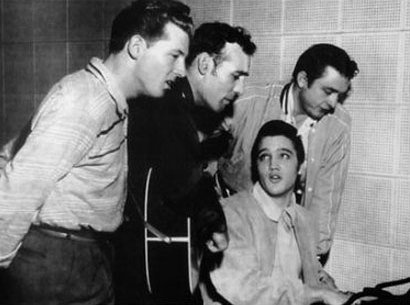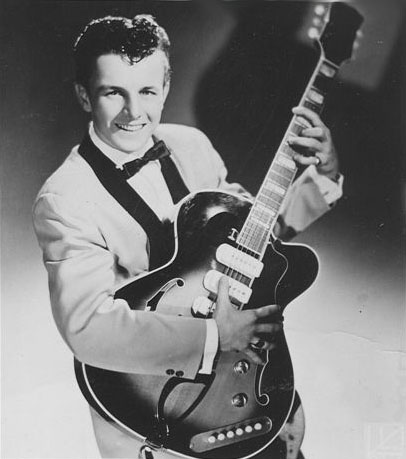Each week, Frequency Rotation probes a different song with a science fiction or fantasy theme. Genre, musical quality, and overall seriousness may vary.
Earlier this year I wrote a feature for Clarkesworld called “Moonage Daydream: The Rock Album as Science Fiction.” In it, I point out that rock ’n’ roll’s love affair with science fiction began when rock ’n’ roll as a mass movement did, in the early ’50s. Back then, of course, space travel fell strictly within the realm of science fiction. But in January of 1957—and with Moscow’s sudden, unexpected launch of Sputnik still nine months away—a gaggle of hillbillies assembled in Memphis to record a song that gleefully anticipated the coming Space Age. (Or at the very least, it gleefully anticipated that weekend’s trip to see a science-fiction double-bill down at the local drive-in.)
That two-minute blast of hootin’, hollerin’, hillbilly racket was titled, bluntly enough, “Flyin’ Saucers Rock ’n’ Roll.” The band was Billy Lee Riley and His Little Green Men. And among those Little Green Men was a young, maniacal, hotheaded piano player, a freckle-faced kid who was mere months away from being launched into an orbit of his own: Jerry Lee Lewis.
In early 1957, Billy Lee Riley, a sharecropper’s son from Pocahontas, Arkansas, had just released his first single, “Rock With Me Baby,” on Sun Records. Sun was the soon-to-be-legendary Memphis label that had recently struck pay dirt with runaway hits by newcomers Carl Perkins, Johnny Cash, and a hip-swiveling heartthrob named Elvis Presley. Sun’s impresario, Sam Phillips, had just sold Elvis’ contract for an unprecedented $40,000 to RCA/Victor, so he was throwing every raucous, backwoods rocker he could find against the wall to see who stuck.
Among those raucous nobodies was Jerry Lee Lewis, a cheap hood, former teenage bigamist, and all-around hellion from Ferriday, Louisiana, who audaciously showed up at Sun Studios in 1956 looking to audition for Phillips. The audition worked, and Sun released Lewis’ debut single, “Crazy Arms,” later that year. It was a modest regional hit, but otherwise went nowhere. But after an impromptu jam session at Sun Studios in Memphis on December 4, 1956, that involved Lewis, Perkins, Presley, and Cash—a one-time convocation that has since been dubbed the Million Dollar Quartet—Lewis’ star began to rise.

Lewis’ breakthrough single, “Whole Lotta Shakin’ Going On,” was released the summer after he jammed with Elvis and the boys. During the intervening six months, though, Lewis was still just a poor kid in a strange town struggling to survive. So he agreed to become a sideman for Riley. Lewis had to swallow some pride to take the gig, especially seeing as how Riley made his Little Green Men actually dress like little green men onstage—and the dye from their cheap costumes mixed with their sweat and stained their skin, turning them literally into green men. Naturally, Lewis quit Riley’s band the instant “Whole Lotta Shakin’ Going On” took off—but he did stick around long enough to record one single as a member of Riley’s Little Green Men: the immortal “Flyin’ Saucers Rock ’n’ Roll.”
When I call “Flyin’ Saucers” a blast of hootin’, hollerin’ hillbilly racket, I mean it. Like the best specimens of early rock ’n’ roll, the single mixes R&B, jump blues, boogie-woogie, country & western, and sheer, hormonal dementia into a snarling slab of cacophony. That you can dance to. And the lyrics, you have to admit, are divinely inspired: “Well the news of the saucer went a flyin’ around/ Saw one landin’, and it sat there on the ground/ The first thing that happens when the spaceship lands/ Guys jumped out and they started the band,” howls Riley, who then diplomatically adds, “Well I couldn’t understand anything they said/ But their rock ’n’ roll beat is just stoppin’ me dead.” Even better are the random, throat-rupturing shrieks that punctuate “Flyin’ Saucers”—presumably the horrified reaction of your average passerby at the sight of this uneasy, human-alien hoedown.
Not to read too much into the song sociologically, but in many ways, the rock ’n’ roll music of the ’50s was an uneasy—and often unwitting—collaboration between two separate and mutually alien cultures: black and white. Rock ’n’ roll, both the term and the music itself, had been created by African-Americans many years before whites took notice, absorbed the idiom, and then packaged and marketed rock ’n’ roll in a more socially acceptable form to other whites. Not that Riley and his band likely had race relations, the moral implications of musical miscegenation, and the onrushing Civil Rights Movement in mind while they were yelling their heads off and pounding away at their instruments as if they were trying to either put out or fan a fire.
While we can pretty much rule out social consciousness as one of Riley’s muses, it’s still tough to pinpoint exactly what inspired him to write his alien-invasion anthem. His choice of band name “Little Green Men,” though, might be a clue. By 1957, the term had been in circulation for at least 20 years; a newspaperman in Corpus Christie named Bill Barnard had written about “little green men” in 1938 while poking fun at Orson Welles’ infamous War of the Worlds radio scare. But the term had been resurrected, quite colorfully, in 1955, when members of the Sutton family of the hills of Christian County, Kentucky—just a couple hundred miles northeast of Memphis—claimed to have been terrorized by a tribe of small, mischievous, green-skinned beings. From another planet. (If only they’d bottled and bootlegged the white lightning they’d been cooking there in Christian County, the psychedelic revolution might have been bumped up by a full decade.)

The terrified Suttons of the Kelly-Hopkinsville Encounter, as the incident came to be known, claimed that these extraterrestrial elves (which, by the way, align perfectly with Robert Anton Wilson’s pseudo-Jungian theory that little green men are the 20th century’s incarnation of the trickster archetype—but I digress) descended on their farmhouse in a flying saucer. The flying saucer, of course, is another archetypal image that has popped up in various guises throughout the centuries. Riley may not have been thinking about the Kelly-Hopkinsville Encounter the day he named his band and titled his song, but it’s hard to imagine that such an infamous incident in his veritable backyard wouldn’t have captured his fancy.
Granted, Riley might have simply sat through too many of those science-fiction double-bills at the drive-in (perhaps nursing a little white lightning of his own). The ’50s were the heyday of the alien-invasion flick, and 1956 alone saw the release of such masterwork of thinly-veiled Cold War paranoia as Roger Corman’s It Conquered the World and, sure enough, Earth vs. the Flying Saucers, one of the first films to feature visual effects by stop-motion legend Ray Harryhausen. The aliens in those movies, though, most definitely did not come to Earth to rock and/or roll.
As even the most casual rock fan may have already guessed, “Flyin’ Saucers Rock ’n’ Roll” did not become a huge hit for Billy Lee Riley. And yet, after one more underperforming single for Sun, he moved to Brunswick Records and released 1958’s “Rockin’ on the Moon,” a single that sought to capitalize on the admittedly limited success of “Flyin’ Saucers.” It didn’t. Compared to its predecessor, “Rockin’ on the Moon” is a relatively tame and novelty-like, even if it does bear these incredible, proto-psychedelic lines: “One cat said, ’Boy, come and dig our queen’ / I looked at her, and I thought I’d scream / Eyes in the back of her head, what a sin / Couldn’t tell where she’s goin’, but she knows where she’s been.”
Neglected by the record-buying public of its time, “Flyin’ Saucers Rock ’n’ Roll” has had its revenge. It’s considered a classic by those who like to bestow classic-status upon such things, and it’s since been covered by rockabilly revivalists like Robert Gordon and Brian Setzer. Neither remake, though, can touch the fire and fury—not to mention the Jerry Lee Lewis-fueled, pre-Sputnik delirium—of the Little Green Men’s original. And who knows? Maybe someday, when aliens really do land on Earth, our governments will be able to use “Flyin’ Saucers Rock ’n’ Roll” as a blueprint for cultural integration and pangalactic harmony. Depending, of course, on your definition of harmony.
Jason Heller is a regular contributor to The A.V. Club; plays the guitar; and considers Nick Tosches’ Hellfire: The Jerry Lee Lewis Story to be the finest rock ’n’ roll biography written on this or any other planet.










